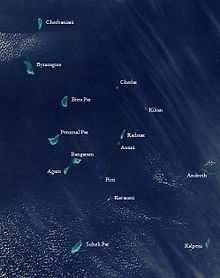Cherbaniani Reef


Cherbaniani Reef, also known as Beleapani Reef (Malayalam: Valiyapanniyam), is a coral atoll[1] belonging to the Amindivi Subgroup of islands of the Union Territory of Lakshadweep, India.
It is located 33 km north of Byramgore Reef and at 12°18′N 71°53′E / 12.300°N 71.883°E it is the northwesternmost feature of Lakshadweep. The atoll has a roughly oval shape and was first described by ornithologist Allan Hume in 1876;[2] its total area is 170 km².[3]
Ecology
The 14 km long coral reef that encloses the lagoon has two small uninhabited islands on it. They are composed of accumulated coral sand, shingle, cuttle-bones and sea shells. There are many land hermit crabs under the boulders and among the detritus.[4] The atoll used to be a breeding ground for pelagic birds, including the Sooty Tern (Sterna fuliginosa) and Brown Noddy (Anous stolidus), which were formerly found in great numbers.[5]
Lakshadweep islanders from Chetlat and Bitra sometimes visit the islands to collect guano for the gardens in the main inhabited islands, gathering eggs, dumping garbage and disturbing the nestlings of pelagic birds in the process. The beaches are strewn with marine litter composed mainly of oceanic flotsam deposited by currents, like plastic bottles, glass bulbs, polystyrene foam and cans.[6]
References
- ↑ Cherbaniani Reef, India
- ↑ Hume, Allan O., The Laccadives and the West Coast, Stray Feathers. (Calcutta), IV (1876), 413-83. 21.
- ↑ Cherbaniani Reef - Oceandots at the Wayback Machine (archived December 23, 2010)
- ↑ W.A. Taylor, FRSE, Geographical Notes, Scottish Geographical Magazine, Volume 8, Issue 11, 1892
- ↑ Birds of Lakshadweep Islands
- ↑ P.S.B.R. James, The Lakshadweep: Islands of Ecological Fragility, Environmental Sensitivity and Anthropogenic Vulnerability, Journal of Coastal Environment
External links
- Hydrographic Description (Indian Ocean Pilot)
- Lagoon sizes
- Cherbaniani Reef - Geographical information
- Seamount Catalog - Cherbaniani Reef Seamount
- List of Atolls
- An ornithological expedition to the Lakshadweep archipelago
- Sources towards a history of the Laccadive Islands
| ||||||